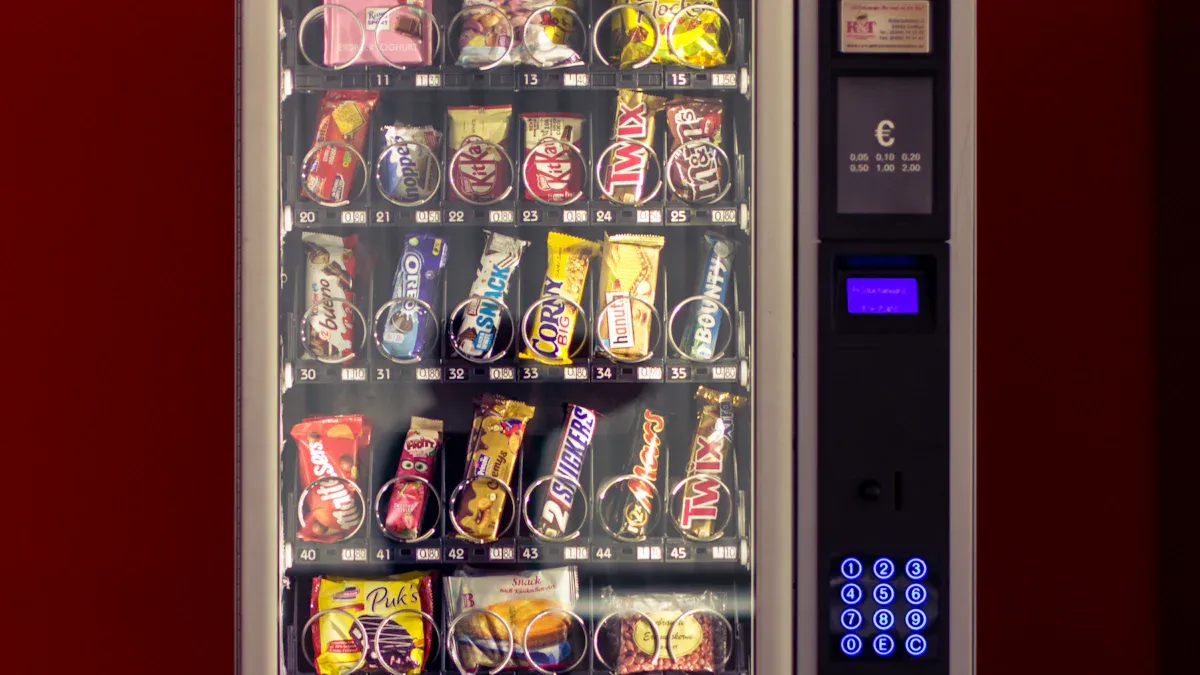Vending Machine Error Codes

Vending machine error codes are diagnostic messages displayed when technical issues occur. These codes help you identify problems quickly, saving time and resources. Understanding them ensures smooth vending machine operations, reducing downtime and improving customer satisfaction. By decoding these messages, you can maintain efficiency and enhance your business performance.
Key Takeaways
Vending machine error codes help find problems fast. They keep things running well and make customers happy.
Checking error codes often can stop small problems from growing. This saves time and money later.
Teaching workers to fix common error codes helps them solve problems quickly. This cuts waiting time and makes service better.
Understanding Vending Machine Error Codes
What Are Vending Machine Error Codes?
Vending machine error codes are diagnostic messages that help you identify technical issues. These codes act as a language between the machine and you, providing insights into its operational status. When a vending machine encounters a problem, it displays a specific code to indicate the nature of the issue. For example, a code might signal a jammed product dispenser or a malfunctioning payment system.
Error codes are typically alphanumeric, combining letters and numbers to represent different types of faults. Some machines use simple codes like "E01" for general errors, while others employ more detailed codes that pinpoint specific problems. By understanding these codes, you can quickly determine what needs attention and take appropriate action.
Tip: Keep the machine's user manual handy. It often includes a list of error codes and their meanings, making troubleshooting easier.
Why Do Vending Machines Display Error Codes?
Vending machines display error codes to ensure smooth operations and minimize downtime. These codes serve as a built-in diagnostic tool, helping you identify and resolve issues before they escalate. Without error codes, pinpointing the source of a problem would be time-consuming and inefficient.
Error codes also play a crucial role in maintaining customer satisfaction. Imagine a vending machine failing to dispense a product or accept payment. The displayed code allows you to address the issue promptly, ensuring the machine remains functional and reliable. Additionally, error codes help technicians perform repairs more efficiently by providing a clear starting point for troubleshooting.
Note: Regularly monitoring error codes can prevent minor issues from turning into major problems, saving you time and money in the long run.
Common Fault Codes in Vending Machines

Payment System Fault Codes
Payment system fault codes indicate issues with the machine's ability to process transactions. These errors often stem from problems with card readers, cash acceptors, or digital payment systems. For example, a vending machine might display an "efl8 error code" when the payment system fails to authorize a transaction. This could result in an out of service machine, frustrating customers and reducing sales.
Common payment-related fault codes include:
Fraud reason codes (10.1-10.5): These highlight issues like stolen cards, which can prevent legitimate transactions.
Authorization reason codes (11.1-11.3): These indicate failures in transaction approval, leading to declined payments.
Processing errors (12.1-12.7): These cover mistakes like incorrect amounts, affecting transaction accuracy.
Customer dispute reasons (13.1-13.9): These relate to order fulfillment issues, which can harm customer relationships.
Understanding these codes helps you troubleshoot payment failures and maintain smooth operations.
Product Dispensing Fault Codes
Product dispensing fault codes occur when the machine fails to deliver items correctly. These errors may result from jammed dispensers, empty slots, or mechanical malfunctions. For instance, a code like "E02" might signal a jammed spiral coil, preventing the product from dropping. Regular maintenance and prompt resolution of these issues ensure customer satisfaction and reduce downtime.
Temperature Control Fault Codes
Temperature control fault codes are critical for vending machines storing perishable items. These codes alert you to issues like overheating or cooling failures. For example, a code might indicate that the internal temperature exceeds safe limits, risking product spoilage. Addressing these errors promptly protects product quality and prevents revenue loss.
Communication and Connectivity Fault Codes
Communication and connectivity fault codes highlight problems with the machine's ability to connect to networks or communicate with external systems. These errors can disrupt remote monitoring, payment processing, or inventory updates. A common example is a "network error" code, which may occur due to poor signal strength or hardware issues. Ensuring stable connectivity minimizes these disruptions.
Power Supply and Hardware Fault Codes
Power supply and hardware fault codes signal issues with the machine's internal components. These errors can arise from manufacturing defects, component fatigue, or environmental factors. For example, a vending machine might display a code indicating a power surge or hardware failure. Studies show that advanced devices are prone to faults during their operational lifespan, often due to transient effects or external influences. Regular inspections and fail-safe mechanisms can enhance reliability and reduce downtime.
Tip: Redundant systems can help maintain operations even when some components fail, ensuring uninterrupted service.
Troubleshooting Vending Machine Error Codes
Identifying the Error Code
The first step in troubleshooting vending machine error codes is identifying the specific code displayed. These codes act as a guide, pointing you toward the root cause of the issue. Start by checking the machine's display panel or diagnostic screen. Most vending machines show the error code prominently, making it easy to spot.
Refer to the machine's user manual for a detailed explanation of the code. Manuals often include a list of error codes and their meanings, helping you understand what the machine is trying to communicate. For example, a code like "E02" might indicate a jammed product dispenser, while "EFL8" could signal a payment system failure. If the manual is unavailable, many manufacturers provide online resources or customer support to assist with code identification.
Real-world examples highlight the importance of correctly identifying error codes. At the University of Waterloo, vending machines displayed an error code related to facial recognition technology. The code, "Invenda.Vending.FacialRecognition.App.exe — Application error," revealed a controversial feature that led to the machines' removal. This example underscores how error codes can provide critical insights into a machine's functionality.
Tip: Always document the error code before attempting any repairs. This ensures you have a reference point if further assistance is needed.
Steps to Resolve Common Fault Codes
Once you've identified the error code, follow a systematic approach to resolve the issue. Begin with basic troubleshooting steps to address common problems. Here are some industry-recommended methods:
Clear any existing errors before adding new components like telemetry or cashless devices.
Ensure all cables are securely connected and in the correct positions. Loose connections often cause malfunctions.
Use a known good cable to isolate potential wiring issues.
Test the payment system with a swipe card to verify its functionality.
If you're knowledgeable, use a multimeter to check voltage and current levels.
Maintain proper cable management to prevent accidental disconnections.
For example, if the machine displays a payment system error, start by inspecting the card reader and cash acceptor. Clean these components to remove dirt or debris that might interfere with their operation. If the issue persists, test the reader with a known good card to confirm its functionality. Similarly, for product dispensing errors, check for jammed items or empty slots and resolve these issues promptly.
Note: Always power off the machine before performing any repairs to ensure safety.
When to Contact Technical Support
Some vending machine error codes require professional assistance. Knowing when to contact technical support can save you time and prevent further damage. If basic troubleshooting doesn't resolve the issue, or if the error code indicates a complex problem, it's time to seek help.
Industry best practices recommend using diagnostic tools and error code databases to determine whether technical support is necessary. These resources provide detailed information about error codes and their solutions. For example, a database might reveal that a specific code requires specialized equipment or expertise to address.
The following table outlines scenarios where contacting technical support is advisable:
Evidence Type | Description |
|---|---|
Essential for diagnosing and resolving issues efficiently, minimizing downtime and ensuring performance. | |
Error Code Databases | Provide comprehensive information about error codes, aiding in troubleshooting and solution finding. |
Step-by-Step Troubleshooting Process | Involves defining the problem from both user and technical perspectives, gathering relevant information. |
If you encounter persistent power supply issues or hardware failures, technical support can provide the expertise needed to repair the machine. They can also assist with advanced diagnostics, ensuring the machine returns to optimal performance.
Reminder: Keep a record of the error code and the steps you've taken to resolve it. This information will help technicians diagnose the problem more efficiently.
The Role of Cloudpick’s Unmanned Store in Error Management

How Cloudpick’s AI Technology Minimizes Errors
Cloudpick’s AI technology helps you reduce operational errors by automating key processes. Tasks like product tracking and payment processing no longer require human intervention. This automation ensures vending machines operate smoothly and profitably. For example, the system tracks inventory levels in real time, preventing stockouts and waste. You can rely on this technology to monitor stock accurately and maintain consistent product availability. By minimizing manual tasks, the risk of human error decreases significantly, allowing your vending machines to deliver a seamless experience.
Real-Time Monitoring and Smart Replenishment Features
Real-time monitoring and smart replenishment features keep your vending machines running efficiently. These tools provide constant updates on stock levels, ensuring you never run out of popular items. Here’s how they work:
The system alerts you when supplies are low, helping you restock before products run out.
It automatically generates restocking orders based on sales data, saving you time and effort.
High-demand products receive priority, reducing unnecessary trips and improving efficiency.
These features allow you to focus on what matters most—delivering a reliable service to your customers.
Enhancing Operational Efficiency with Cloudpick’s Unmanned Store
Cloudpick’s unmanned store enhances your operational performance in multiple ways. The table below highlights some of its key benefits:
Feature | Benefit |
|---|---|
Enhanced Customer Experience | Offers a frictionless shopping experience without lines or cashiers. |
Real-Time Inventory Management | Tracks inventory with IoT sensors, preventing stock issues. |
Improved Personalization | Provides tailored recommendations based on past purchases. |
Waste Reduction | Discounts nearly expired items, minimizing losses. |
By leveraging these features, you can streamline operations, reduce waste, and improve customer satisfaction. Cloudpick’s innovative solutions ensure your vending machines remain efficient and profitable.
Preventing Vending Machine Errors
Regular Maintenance and Cleaning
Regular maintenance keeps your vending machines running smoothly and prevents unexpected breakdowns. You should inspect mechanical and technical components frequently to catch early signs of wear and tear. Testing and calibrating sensors ensures accurate product dispensing, while inspecting cooling systems helps maintain product quality, especially during warmer months.
Perform regular inspections to identify subtle issues.
Test sensors to ensure they function correctly.
Check cooling systems to avoid spoilage.
Keep detailed maintenance records to track performance and plan replacements.
Routine cleaning also plays a vital role. Dust and debris can interfere with sensors and moving parts. Wiping down surfaces and clearing internal components reduces the risk of malfunctions.
Tip: Schedule maintenance checks monthly to stay ahead of potential problems.
Monitoring Software and Hardware Updates
Keeping your vending machine’s software and hardware up to date improves reliability and reduces errors. Conduct regular diagnostics to identify issues early. Update firmware to access new features and security patches. Establishing a maintenance schedule prevents unexpected downtime.
Metric Type | Impact on Error Management |
|---|---|
Data Accuracy | Reduces numerical errors through electronic systems. |
Operational Efficiency | Improves productivity and reduces human error. |
Predictive Maintenance | Resolves issues proactively, minimizing downtime. |
AI-powered systems can further enhance maintenance. These tools analyze usage patterns to predict failures, allowing you to address issues before they disrupt operations.
Proper Installation and Placement
Installing vending machines correctly ensures optimal performance. Place machines on level surfaces to prevent mechanical strain. Avoid areas with extreme temperatures or high humidity, as these conditions can damage internal components. Ensure proper ventilation to prevent overheating.
Reminder: Position machines in high-traffic areas to maximize visibility and usage.
Staff Training for Basic Troubleshooting
Training your staff equips them to handle minor issues without needing technical support. Teach them to identify common error codes and perform basic fixes, such as clearing jams or resetting the machine. Provide a quick-reference guide for troubleshooting steps.
Note: Well-trained staff can resolve issues faster, reducing downtime and improving customer satisfaction.
Understanding vending machine error codes ensures smooth operations and reduces downtime. These codes help you identify issues quickly, improving customer satisfaction and operational efficiency.
Cloudpick’s Unmanned Store automates tasks like product tracking and payment processing, reducing costs and enhancing reliability. Its AI technology ensures continuous operation, keeping machines profitable and responsive.
Metric | Value/Description |
|---|---|
Customer Satisfaction Score | |
Operational Downtime Percentage | Target of under 5% downtime |
Inventory Turnover Ratio | Indicates stock replenishment needs |
Proactive maintenance and monitoring prevent errors, ensuring your vending machines deliver consistent performance.
FAQ
What should you do if a vending machine displays an unknown error code?
Check the user manual or contact the manufacturer’s support team. They can provide detailed explanations and solutions for unfamiliar error codes.
How can you prevent vending machine errors caused by power surges?
Use surge protectors to safeguard the machine’s electrical components. Regularly inspect the power supply for stability and replace faulty wiring promptly.
Can Cloudpick’s Unmanned Store handle error codes automatically?
Yes, Cloudpick’s AI technology identifies and resolves errors in real time. It ensures uninterrupted operations and reduces the need for manual troubleshooting.
See Also
Understanding The Expenses Associated With Vending Machines
Pricing Details For Personalized Vending Machines
Expenses Involved In Obtaining Vending Machine Permits
Exploring Collectible Items From Vending Machines
Essential Smart Features To Consider When Purchasing Vending Machines
